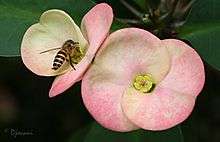Apis cerana indica
| Apis cerana indica | |
|---|---|
 | |
| Scientific classification | |
| Kingdom: | Animalia |
| Phylum: | Arthropoda |
| Class: | Insecta |
| Order: | Hymenoptera |
| Suborder: | Apocrita |
| Superfamily: | Apoidea |
| Family: | Apidae |
| Subfamily: | Apinae |
| Tribe: | Apini |
| Genus: | Apis |
| Species: | A. cerana |
| Subspecies: | A. c. indica |
| Trinomial name | |
| Apis cerana indica Fabricius | |
Apis cerana indica, the Indian honeybee or Eastern honeybee, is a subspecies of honey bee. It is one of the predominant bees found and domesticated in India, Pakistan, Nepal, Burma, Bangladesh, Sri Lanka, Thailand and mainland Asia. Relatively non-aggressive and rarely exhibiting swarming behavior, it is ideal for beekeeping.
It is similar to the European honey bee (Apis mellifera), which tends to be slightly larger and can be readily distinguished.
They usually build multiple combed nest in tree hollows and man-made structures. These bees can adapt to living in purpose-made hives and cavities. Their nesting habit means that they can potentially colonize temperate or mountain areas with prolonged winters or cold temperatures.
It is one of the important pollinators for coconut palms; the other species are Apis florea, Apis dorsata and Apis mellifera (the European bee).[1]
References
- ↑ P.K. Thampan. 1981. Handbook on Coconut Palm. Oxford & IBH Publishing Co.
- Benjamin P. Oldroyd and Siriwat Wongsiri. Asian Honey Bees (Biology, Conservation, and Human Interactions). 2006: Harvard University Press, Cambridge, Massachusetts and London, England.
- Tautz, J and M. Lindauer. 1997. "Honeybees establish specific nest sites on the comb for their waggle dances". Journal of Comparative Physiology 180:537-539.